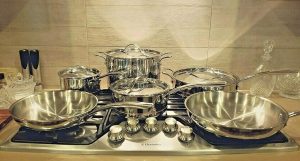Exploring Common Kitchen Layouts: From Galley to Work Zones
A well-designed kitchen is the heart of any home, catering to both functional needs and aesthetic preferences. To make informed choices about your kitchen’s layout, it’s essential to understand the characteristics of common layouts and how they can influence your cooking experience and lifestyle. In this comprehensive guide, we’ll explore the most prevalent kitchen layouts, from efficient galley kitchens to open concept designs, helping you make an informed decision for your culinary space.
1. Galley Kitchen

Layout Description: A galley kitchen features two parallel countertops or cabinet runs, creating a compact and efficient workspace. This layout is ideal for smaller spaces and provides a straightforward, linear flow for cooking and preparation.
Key Features:
- Efficient Use of Limited Space: Galley kitchens excel in maximizing every inch of available space, making them perfect for apartments, condos, and smaller homes.
- Linear Workflow: With everything within arm’s reach, the linear design minimizes unnecessary movement while cooking or cleaning.
- Ideal for Single-Cook Kitchens: Galley kitchens are well-suited for homes with one primary cook, allowing for a streamlined cooking process.
Pros:
- Space-efficient and Economical: Galley kitchens are among the most space-efficient layouts, making the most of every square foot.
- Ideal for Apartments and Small Homes: Their compact design is ideal for homes with limited space.
- Simplified Workflow: With a clear path from one end to the other, cooking and cleaning become more straightforward.
Cons:
- Limited Countertop Space: Galley kitchens may suffer from limited countertop space, making food preparation challenging for multiple cooks.
- Potential for Feeling Cramped: In smaller galley kitchens, multiple cooks may find the space tight.
- Challenging for Creating a Dining Area: There may be limited space for a dining table within the kitchen.
2. L-Shaped Kitchen

Layout Description: An L-shaped kitchen is characterized by countertops or cabinets arranged in an “L” shape, making use of two adjacent walls. This design offers versatility and efficient work zones.
Key Features:
- Effective Use of Corner Space: L-shaped kitchens make efficient use of corner space, often incorporating clever storage solutions.
- Flexibility for Multiple Workstations: With two adjacent walls, this layout allows for multiple workstations, perfect for families or those who love to cook together.
- Ideal for Open Floor Plans: L-shaped kitchens work well in open concept homes, often connecting seamlessly to dining or living areas.
Pros:
- Efficient Use of Space and Workflow: L-shaped kitchens offer an efficient work triangle, ensuring a smooth cooking process.
- Room for an Island or Dining Table: In open concept homes, there’s often enough space to add an island or dining table, enhancing versatility.
- Suitable for Various Kitchen Sizes: Whether your kitchen is compact or spacious, the L-shape can be adapted to fit your needs.
Cons:
- May Require Adequate Wall Space: To fully benefit from this layout, you’ll need enough wall space for the “L.”
- Limited Space for Larger Kitchens: In extremely large kitchens, an L-shaped layout may feel somewhat constrained.
- Careful Planning Needed for Corner Storage Solutions: Utilizing corner space efficiently can be a design challenge.
3. U-Shaped Kitchen

Layout Description: The U-shaped kitchen boasts countertops and cabinets along three walls, creating a U-shaped configuration. This design offers ample storage and workspace, making it a popular choice for larger kitchens.
Key Features:
- Maximizes Storage and Counter Space: U-shaped kitchens are known for their abundant storage and countertop space, catering to avid cooks and large families.
- Efficient Work Zones: With three distinct walls of workspace, this layout encourages efficient work zones and organization.
- Ideal for Multiple Cooks: U-shaped kitchens are well-suited for households with multiple cooks, as there’s ample room for collaboration.
Pros:
- Abundant Storage and Workspace: U-shaped kitchens excel in providing room for both storage and preparation.
- Well-suited for Larger Families and Avid Cooks: If you love to cook or have a big family, this layout is an excellent choice.
- Encourages a Defined Kitchen Work Triangle: The U-shape naturally establishes a well-defined work triangle for cooking efficiency.
Cons:
- May Require a Spacious Kitchen Area: U-shaped kitchens require more space, which may not be feasible in smaller homes or apartments.
- Potential for a Closed-off Feel in Small Spaces: In compact U-shaped kitchens, the layout may create a somewhat closed-off atmosphere.
- Careful Planning Needed to Avoid Overcrowding: With three walls of cabinetry, it’s important to plan the layout to avoid overcrowding and maximize efficiency.
4. Open Concept Kitchen

Layout Description: Open concept kitchens break down traditional barriers between the kitchen and adjacent living spaces, promoting an open and inclusive atmosphere. They often feature islands or peninsulas as central focal points.
Key Features:
- Creates a Spacious, Connected Living Environment: Open concept kitchens seamlessly blend with living areas, creating an expansive, interconnected living space.
- Promotes Social Interaction: These layouts encourage socializing and interaction while cooking, making them perfect for families and entertainers.
- Ideal for Entertaining: Open concept kitchens are perfect for hosting gatherings, as guests can socialize with the cook while food is prepared.
- Expansive Design Possibilities: The open concept provides design flexibility, allowing you to tailor the space to your unique preferences.
Pros:
- Creates a Spacious, Connected Living Environment: Open concept kitchens seamlessly blend with living areas, creating an expansive, interconnected living space.
- Promotes Social Interaction: These layouts encourage socializing and interaction while cooking, making them perfect for families and entertainers.
- Ideal for Entertaining: Open concept kitchens are perfect for hosting gatherings, as guests can socialize with the cook while food is prepared.
- Expansive Design Possibilities: The open concept provides design flexibility, allowing you to tailor the space to your unique preferences.
Cons:
- Requires Careful Planning for Functional Zones: Without walls to separate spaces, careful planning is necessary to define functional zones and maintain organization.
- May Be Noisy and Less Private: The openness can lead to increased noise and less privacy, which may not suit every homeowner’s preferences.
- Cooking Odors Can Spread: Without walls to contain cooking odors, they can easily spread to adjacent spaces, requiring effective ventilation solutions.
5. Island Kitchen

Layout Description: Island kitchens feature a central island that serves as both a workspace and a focal point. This design adds extra countertop space, storage, and versatility to your kitchen.
Key Features:
- Provides Additional Countertop Space and Storage: Islands offer extra workspace and storage, making them ideal for larger kitchens.
- Creates a Natural Gathering Point: Islands often become the heart of the kitchen, serving as a hub for socializing and dining.
- Accommodates Bar Seating: Many island kitchens feature bar seating, creating a space for casual dining or chatting with the cook.
- Enhances Workflow with a Centralized Work Area: Islands centralize the kitchen’s work area, improving efficiency by reducing the distance between key components like the stove, sink, and refrigerator.
- Maximizes Workspace and Storage: Islands provide additional workspace and storage, which is especially beneficial for larger kitchens.
- Ideal for Both Cooking and Entertaining: Island kitchens seamlessly blend cooking and socializing, making them perfect for both daily meal preparation and hosting guests.
- Allows for Creative Design Elements: Islands offer opportunities for unique design elements, such as decorative lighting, contrasting countertops, and custom cabinetry.
Cons:
- Requires Adequate Floor Space: To incorporate an island, you’ll need sufficient floor space, which may not be available in smaller kitchens.
- May Not Be Suitable for Smaller Kitchens: In compact kitchens, islands can make the space feel cramped and inhibit movement.
- Careful Planning Needed for Traffic Flow: Proper spacing around the island is crucial to avoid congestion and maintain accessibility.
6. Kitchen Work Zones

Layout Description: Kitchen work zones involve dividing your kitchen into distinct areas or zones, each dedicated to a specific task or function. This approach optimizes organization and efficiency.
Key Features:
- Separates Cooking, Prep, Cleaning, and Storage Areas: Work zones divide the kitchen into areas dedicated to specific functions, reducing clutter and streamlining tasks.
- Tailors the Kitchen to Your Cooking Habits: Customizable work zones allow you to design your kitchen around how you use it most, whether you’re an avid baker, a chef, or a busy parent.
- Enhances Workflow and Minimizes Clutter: Work zones promote a well-organized and efficient kitchen by focusing on specific tasks in designated areas.
Pros:
- Streamlines the Cooking Process: Work zones create a natural flow for meal preparation, making it easier to find and access necessary ingredients and tools.
- Reduces Kitchen Chaos: By separating tasks and supplies, work zones prevent kitchen chaos, promoting a more organized and enjoyable cooking experience.
- Customizable to Suit Your Needs: You can tailor work zones to your unique cooking habits and preferences, creating a kitchen that works specifically for you.
Cons:
- Requires Thoughtful Planning and Design: Implementing work zones necessitates careful planning and design considerations to ensure functionality and efficiency.
- May Involve Restructuring Existing Layouts: In some cases, creating work zones may require structural changes or renovations to your existing kitchen layout.
- Initial Investment in Organization Solutions: To optimize work zones, you may need to invest in organizational solutions such as cabinetry, shelving, and storage systems.
Conclusion
When it comes to kitchen layouts, there is no one-size-fits-all solution. Your choice should align with your cooking style, available space, and lifestyle preferences. Whether you opt for a compact galley kitchen, embrace the open concept, or choose another layout, understanding the key features, pros, and cons of each design will empower you to create a culinary space that not only functions efficiently but also enhances your daily life and reflects your personal style.
Before making a decision, consider your household’s needs, the available space, and how you envision your kitchen being used. Whether you prioritize ample workspace, social interaction, or organization, there’s a kitchen layout that’s perfect for you. Ultimately, your kitchen should not only serve as a functional space but also as a hub for creativity, nourishment, and connection within your home.



